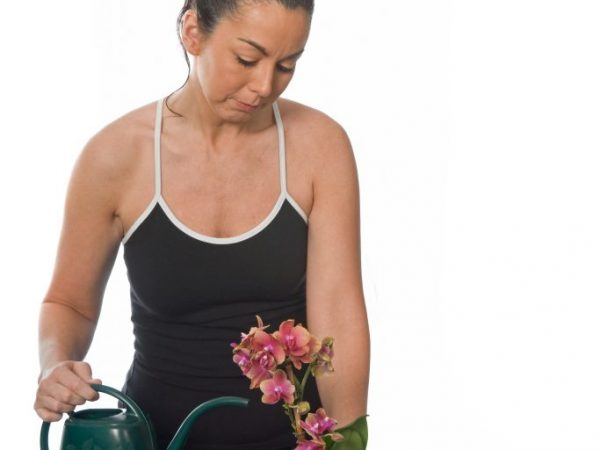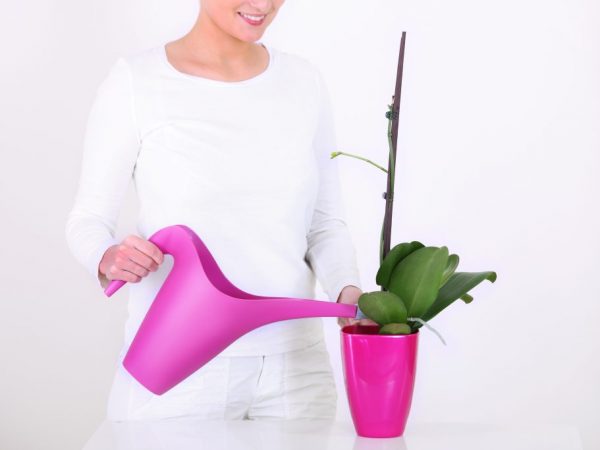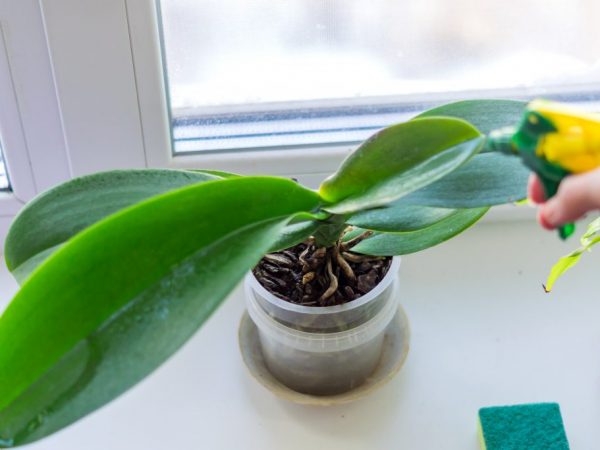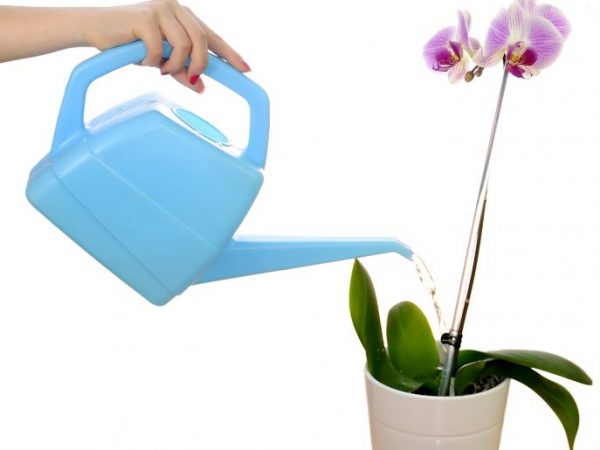Features of watering orchids
Indoor plant lovers often have orchids at home. This culture attracts with bright exotic flowers. In order for phalaenopsis to grow well and delight with flowering for a long time, it should provide the necessary conditions for life. One of the important aspects of maintenance is watering the orchid.
- Features of watering orchids
- Irrigation water
- Watering flowers with distilled water
- How often orchids are watered
- Watering orchids on different occasions
- Watering during flowering
- Watering in winter
- Watering after buying a flower
- Watering after transplant
- Ways to water orchids
- Watering from a watering can
- Immersion irrigation
- Spraying the root system
- Orchid feeding
- Conclusion

Features of watering orchids
Features of watering orchids
Orchids are exotic flowers that grow in the wild mainly in areas of high humidity and hot climates. These flowers belong to epiphytic moisture-loving plants that grow on the bark of trees, clinging to their branches with powerful aerial roots, as well as on stones and rocks.
Orchids do not lead a parasitic lifestyle; they receive all the necessary nutrients from the atmosphere, absorbing moisture after dew, fog or rain. At home, for normal life, they need proper watering and moisture.
Irrigation water
All phalaenopsis species and varieties have specific water requirements for irrigation. The health and condition of the plant is influenced by its quality, composition and temperature. It is better to water an orchid at home with rain or melt liquid, but there is not always access to it, so flower growers use ordinary tap water.
There are notable advantages of natural water over tap water:
- rain or melt water does not contain mineral salts and acids that can harm the flower;
- Tap water contains complex inorganic compounds and bacteria that settle on roots, leaves and substrate, forming a white bloom, and have a negative effect on phalaenopsis.
Water purification methods
Before watering a delicate and sensitive plant with plain water, it is cleaned of dangerous impurities. Proper watering of orchids involves the use of soft boiled water. During boiling, chlorine compounds volatilize, salts settle and microorganisms are destroyed.
It is also important to water your orchids with water at room temperature or slightly warmer. Some types of phalaenopsis require the temperature of the liquid to be 30 ° C-35 ° C.
There are other ways to purify water: sedimentation and filtration. Watering an orchid with settled water is not so effective. To reduce the concentration of salts and ferrous compounds during the settling of water at room temperature, it takes a long time, during which microorganisms have time to develop, which leads to water bloom. Usually it is defended for one or several days, after which the flowers are watered. This time is not enough for all minerals and acids to disappear.
Using household filters to purify your water is an effective option.Filtered water for watering an orchid is ideal: after it passes through special granular materials, it practically does not contain minerals and dangerous impurities.
If it is not possible to purify the water using filters or boiling, there is an option to reduce the concentration of minerals contained in it using oxalic acid by adding a small amount of it to the liquid. Another treatment option is to run water through high moor peat.
Watering flowers with distilled water

Water must be settled or distilled
To properly water an orchid, experts do not recommend using distilled water, which is almost completely free of organic and inorganic impurities. There are some tips for using it:
- for the cultivation of concentrated fertilizers;
- for spraying the whole flower;
- for flushing the roots before transplanting;
- for cleaning the substrate from salts.
Such water is not suitable for watering plants, it is more suitable for hygiene procedures during flower care. It is good to use it for irrigation, even when the orchid is in bloom, because after it there is no white bloom on the leaves, stems and flowers.
How often orchids are watered
The frequency of watering orchids depends on factors such as air temperature and humidity levels in the room, lighting, season, the period of the flower's life, the composition of the substrate and the size of the pot. Depending on this, the required volume of fluid is increased or decreased. But you can not often water the orchid in order to avoid stagnation of moisture: this leads to rotting of the roots and lower leaves.
Before watering the orchid, check the condition of the substrate: it must be completely dry. On average, watering phalaenopsis is carried out once a week. In the hot period, in spring and summer, the amount of watering is increased up to 1-2 times a week, but on condition that the substrate dries quickly. If, after a week, the substrate remains wet, it is replaced with a larger one to provide ventilation to the roots.
In winter, flowers are watered every 7-10 days. Most orchid species have a dormant period at this time, they lead a passive lifestyle, have already faded, so they do not absorb moisture so quickly.
Watering orchids on different occasions
Watering orchids at home has different characteristics, depending on what life cycle they are in and in what condition. In order for the plant to bloom magnificently and for a long time and develop well, it is important to follow the instructions for proper watering step by step and take into account the advice of skilled flower growers.
Watering during flowering
When phalaenopsis bloom, they form small, flying seeds that can fly over long distances. This is one of the ways they reproduce in the wild. In the rainy season, the seeds cannot fly far due to frequent rains and a large amount of moisture, therefore, at home, they recreate the moisture conditions as in the natural environment.
Watering orchids during flowering should be infrequent but plentiful. It is impossible to saturate the whole flower with moisture well, it is better to water only the roots, but not flood. If the humidity level in the room is low, in addition to the root system, leaves and stems are moistened. In this case, it is important that moisture does not get inside the flower.
As soon as the orchid has bloomed, change the frequency and volume of watering. It is advisable to carry out such a procedure 1-2 times a week after the substrate has completely dried.
Watering in winter

Do not water often in winter.
Watering an orchid in a pot in winter is required much less often than in the hot season or in autumn. Some phalaenopsis species lead an active lifestyle in winter, they may even bloom. But most species are dormant during this period. Despite this, they still need hydration every 10-14 days. This can be done more often if the substrate dries out relatively quickly.
Make sure that excess moisture leaking from the holes in the bottom of the pot does not freeze. Most people have flowers on the windowsill. When moisture in winter flows through the holes in the pot into a saucer or pan, it cools quickly. The roots absorb cold liquid for a week, which leads to hypothermia or the appearance of bacteria and various diseases.
How to avoid hypothermia of the roots
There are several ways to avoid hypothermia of the root system in winter:
- A sheet of foam plastic is laid on a cold windowsill, which will serve as a heat insulator. It is not able to cool down, so the moisture leaked from the flower pots located on it will maintain room temperature.
- Place flower pots in pots with a high bottom without holes. Moisture flowing out of the pots will accumulate at the bottom, at the bottom, of this vessel and keep the original temperature. There are pots made of frost-resistant materials: faience and chamotte - therefore, in such types of decorative vessels, the phalaenopsis will be warm and comfortable.
These simple secrets help protect plants from freezing. Orchids need to be kept warm, especially during the winter.
Warm shower in winter
In winter, Phalaenopsis are given a warm, but not hot shower, since boiling water damages the leaves and roots. It is better to do this in the evening, so that they have time to dry out overnight. It is advisable to leave flower pots in the bathroom. After watering the orchids from the shower, the humidity level in the bathroom rises, so you can enjoy the warm, humid air by leaving the flowers indoors overnight. It also helps to prevent the development of infections and rot at the growing point and the emergence of pests.
Some orchid species are capable of blooming in the winter. For them, it is also recommended to use this method of moisturizing. But it is necessary to water the orchid during flowering from the shower carefully so that moisture does not get into the core of the flower.
Watering after buying a flower
Watering an orchid after purchase is best done in 5-7 days. From the moment of its acquisition, it must go through quarantine to determine the presence of pests and destroy them. At this time, you can also not feed the flower and put it in direct sunlight. Pests appear and multiply in dry climates, if insects are not found after such conditions are created, the plant is clean and healthy.
When pests appear on phalaenopsis, you should immediately begin to fight them so that they do not spread to other plants. To avoid this, it is best to isolate the new orchid from other indoor flowers. After the destruction of the parasites, they proceed to the standard care of the plant. But in the first few days, it is better to leave the flower in the sun for a short period of time, and water it partially.
Watering after transplant
Planting phalaenopsis in a new pot is usually carried out either immediately after purchasing it, or in the spring, after a dormant period. You should not choose a large container for transplanting: the roots develop poorly in it. The flower grows well in a glass or plastic pot.
It is important to transplant and water orchids in the correct order: on the first day after transplanting, moisten the substrate by watering it from above; then, after completely absorbing moisture, the pot for 20 minutes. dipped in a bucket or other container with warm, but not hot, water. Be sure to make sure that the excess moisture in the glass, after which they put the flower in a shaded place.
Proper watering of an orchid after transplanting is a certain frequency and quality of water. The plant should not be watered for the first 2 weeks because it has suffered stress and moisture can have a negative effect. But after the adaptation of phalaenopsis in a new place, it is provided with proper care: only clean boiled water is used to moisturize, fertilizers are periodically applied - all this will accelerate the restoration of the balance of nutrients in the leaves and stems. The flower is watered 2-3 times a week, because.the transplanting time coincides with the flowering period.
Ways to water orchids

Watering with a watering can
Different types of phalaenopsis require different components for the substrate and different watering conditions for stable growth. Depending on this, the regime and methods of watering orchids change.
To make the water more useful for plants, it is saturated with oxygen. To do this, the liquid is poured several times from one container to another.
Watering from a watering can
Among all the ways to water orchids, watering options from a watering can or under running water are the most common and simple. So it is possible to moisten the whole flower at once, because the water pours from above and flows down to the root system. It is better not to water the orchid at home from a watering can, so as not to flood the windowsill or floor. This method is best used outdoors or in the bathroom.
Be sure to make sure that moisture does not accumulate inside the rosette of leaves. They also monitor the state of the substrate: it helps to know when it is necessary to stop watering: water will begin to flow out of the holes in the pot. They wait until the excess moisture drains, and after a while the procedure is repeated 2-4 more times.
After watering, be sure to remove moisture from the axils of the leaves and from the center of the outlet, absorbing it with a napkin or cotton pad. You cannot water a blooming orchid from a watering can. to avoid stagnation of water inside the flowers.
Immersion irrigation
Watering orchids by immersion is used to moisturize and feed, if you add purchased or homemade liquid fertilizers to the water. The flower pot is placed in a bucket or basin with warm water, its edge should be on the surface so that the top of the roots, leaves and stems are dry. With immersion, water will flow to the flower through the holes in the pot. How often an orchid should be watered in this way and how long to keep it in water depends on the type of phalaenopsis, its size and period of life.
The first watering of the orchid by immersion should last 5-10 minutes, after which the flower is given time to get rid of excess moisture. The procedure is repeated as necessary. The moisture content of the substrate helps to understand if re-irrigation is needed. It is important that water does not accumulate in the substrate.
Spraying the root system
Moistening of flowers grown in blocks without a substrate occurs by auto-irrigation, that is, by spraying the root system. Watering an orchid during flowering in this manner is most suitable. To do this, use warm clean water. It is better to irrigate the roots from a spray gun in the "fog" mode so that moisture gets into all areas and is absorbed faster.
This humidification option is not suitable if the flower has just been transplanted or if it has let the children in, as well as after pruning old dead roots.
To determine how often an orchid needs watering, monitor the color of the roots. If they are green, then they are saturated with moisture. As soon as they turn a pale grayish or yellow hue, they are completely dry, and it's time to carry out the next procedure.
Orchid feeding
Experts recommend feeding phalaenopsis while they are hydrated. This is especially convenient for wick irrigation. Fertilizers are usually used as components:
- Tea and coffee: they contain many minerals in low concentrations. Top dressing with tea allows you to acidify the substrate.
- Banana peel: For several days, the peel of one banana is infused in 1 liter of water. The plant is fertilized with an infusion diluted with water in a 1: 1 ratio.
- Orange Peels: An infusion of orange peels is prepared in the same way as a banana peel.
- Yeast: for the preparation of yeast feeding, 1 g of dry or 50 g of live yeast and 1 liter of water are required. The components are insisted for at least 2 hours. Add 1 tsp to dry yeast. Sahara. Before fertilizing with yeast, the infusion is diluted with 5 liters of pure water.
- Glucose or water with sugar: a solution of glucose or sugar is used to spray plants that have suffered dryness or loss of moisture due to loss of roots.The solution is prepared from 1 glucose tablet or 8 ml ampoule and 1 liter of water. The main thing is that the liquid is not too sweet.
- Beer: it is better to fertilize with live, unfiltered beer once every 10 days or 2 times a month in the proportion of 100 ml of beer per 100 ml of warm boiled water.
Sometimes phalaenopsis are fertilized with ammonia. It is a nitrogen source for plants. To prepare the solution, take 3 tbsp. l. ammonia and 5 liters of water. The solution is poured over the root system of the plant. Also, the roots are treated with potassium permanganate. It saves from rot and prevents bacteria and pests.
Conclusion
In order for the orchid to please with long beautiful flowering, it is important to adhere to all the rules of caring for it. Watering is an important aspect. Its frequency and methods depend on different factors and types of phalaenopsis. Before watering a plant, be sure to study its features.


